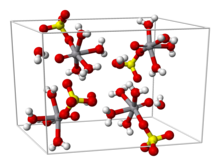Chemical compound From Wikipedia, the free encyclopedia
Vanadyl(IV) sulfate describes a collection of inorganic compounds of vanadium with the formula, VOSO4(H2O)x where 0 ≤ x ≤ 6. The pentahydrate is common. This hygroscopic blue solid is one of the most common sources of vanadium in the laboratory, reflecting its high stability. It features the vanadyl ion, VO2+, which has been called the "most stable diatomic ion".[1]
 | |
 | |
| Names | |
|---|---|
| IUPAC name
Oxovanadium(2+) sulfate | |
| Other names
Basic vanadium(IV) sulfate Vanadium(IV) oxide sulfate Vanadium(IV) oxysulfate | |
| Identifiers | |
| |
| ECHA InfoCard | 100.044.214 |
PubChem CID |
|
| RTECS number |
|
| UNII |
|
CompTox Dashboard (EPA) |
|
| |
| Properties | |
| H10O10SV | |
| Molar mass | 253.07 g·mol−1 |
| Appearance | Blue solid |
| Melting point | 105 °C (221 °F; 378 K) decomposes |
| Soluble | |
| Hazards | |
| Occupational safety and health (OHS/OSH): | |
Main hazards |
Irritant |
| Flash point | Non-flammble |
| Related compounds | |
Other anions |
Vanadyl chloride Vanadyl nitrate |
Other cations |
Vanadium(III) sulfate |
Related compounds |
Vanadyl acetylacetonate |
Except where otherwise noted, data are given for materials in their standard state (at 25 °C [77 °F], 100 kPa).
| |

Vanadyl sulfate is an intermediate in the extraction of vanadium from petroleum residues, one commercial source of vanadium.[2]
Vanadyl sulfate is most commonly obtained by reduction of vanadium pentoxide with sulfur dioxide:
From aqueous solution, the salt crystallizes as the pentahydrate, the fifth water is not bound to the metal in the solid. Viewed as a coordination complex, the ion is octahedral, with oxo, four equatorial water ligands, and a monodentate sulfate.[1][3] The trihydrate has also been examined by crystallography.[4] A hexahydrate exists below 13.6 °C (286.8 K).[5] Two polymorphs of anhydrous VOSO4 are known.[6]
The V=O bond distance is 160 pm, about 50 pm shorter than the V–OH2 bonds. In solution, the sulfate ion dissociates rapidly.
Being widely available, vanadyl sulfate is a common precursor to other vanadyl derivatives, such as vanadyl acetylacetonate:[7]
In acidic solution, oxidation of vanadyl sulfate gives yellow-coloured vanadyl(V) derivatives. Reduction, e.g. by zinc, gives vanadium(III) and vanadium(II) derivatives, which are characteristically green and violet, respectively.
Like most water-soluble sulfates, vanadyl sulfate is only rarely found in nature. Anhydrous form is pauflerite,[8] a mineral of fumarolic origin. Hydrated forms, also rare, include hexahydrate (stanleyite), pentahydrates (minasragrite, orthominasragrite,[9] and anorthominasragrite) and trihydrate - bobjonesite.[10]
Vanadyl sulfate is a component of food supplements and experimental drugs. Vanadyl sulfate exhibits insulin-like effects.[11]
Vanadyl sulfate has been extensively studied in the field of diabetes research as a potential means of increasing insulin sensitivity. No evidence indicates that oral vanadium supplementation improves glycaemic control.[12][13] Treatment with vanadium often results in gastrointestinal side-effects, primarily diarrhea.
Vanadyl sulfate is also marketed as a health supplement, often for bodybuilding. Deficiencies in vanadium result in reduced growth in rats.[14] Its effectiveness for bodybuilding has not been proven; some evidence suggests that athletes who take it are merely experiencing a placebo effect.[15]
Seamless Wikipedia browsing. On steroids.